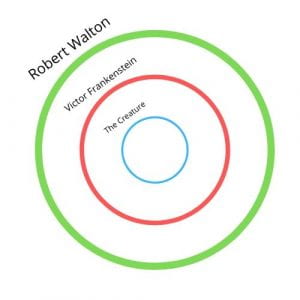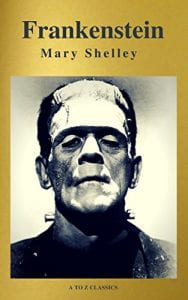Frankenstein – A green, 9-foot tall monster that was created by a mad scientist, right? Well, not exactly.
The Original Frankenstein story is very different from the perceived creature we see represented in Hollywood. First of all, just for clarification, the creature is NOT called Frankenstein (you might have already known that, however before going more in-depth within the story I did not). Frankenstein is the name of the creator, and his creation is referred to as” the creature” or “the monster” never receiving an actual name. The original story derived from the novel Frankenstein, which was written in 1823 by a woman named Mary Shelley. This book is known as the first horror of its kind in the horror genre setting the basis for the ever so popular growing industry that brings in hundreds of millions of dollars every year.
Mary Shelley
Within this original story, there is a sense of mental complexity. Frankenstein is kind of a story within a story within a story. At the beginning of the book, we follow captain Walton while he writes to his sister, describing his expedition to the arctic. We then follow the journey when they find a man (Victor Frankenstein) who is on the search for his creature. Through meeting Victor, the story then takes place through his point of view, telling the story of the creation of the monster and his life. The final perspective within this story is the creature itself, within Victor’s part of the story. So as you can see, the story is pretty confusing.
Before expanding my knowledge about the history of the story, I always assumed the monster was the creature created by Victor Frankenstein. However, after finishing reading the book (and using Sparknotes to gain a deeper understanding of what was happening), and watching the 1931 Frankenstein and Gods and Monsters as well as doing my own research, I’ve determined the real monster within the story is Societal Influences and pressures.
Within the book…
When the monster is first created in the book, Frankenstein states, “breathless horror and disgust filled my heart. Unable to endure the aspect of the being I had created” (Frankenstein; Or, The Modern Prometheus). Victor was not only horrified about the physical appearance of the monster but as terrified toward what others would think of the creature he had created. This set the stage for how society would influence the monster’s character. When the monster was first created, he has no knowledge of how people are treated, nor any knowledge toward how the world works. After his creator’s reaction of fear towards him, the monster left to a village where he received the same response, repulsed and scared by his appearance. After the experiences of being treated like that Frankenstein’s creature stayed away from people, hidden in a hovel outside the DeLacey Family small peasant cottage. From this point on, the creature watched the family and learned how to speak and read.
The turning point in the book is when the creature sees his own reflection in the water and knows what society sees which made him lonely. When the monster asked Victor Frankenstein for a mate, to him he thought it would give him meaning in life. However when Victor refused because he thought that it would do more harm than good this lead to all the monster’s retaliation and revenge towards his creator, killing all of his loved ones. Throughout the entire novel the monster didn’t have an identity with no name and no one who excepted him. Not using a name within the story creates a sense of uncomfortableness making the creature seem inhumane or unbelievable. These techniques are ones used in the “Elements of Aversion”. You can read about how modern horror implement these in my previous two horror posts down below. Society had a major impact on who the creature became, people’s unwillingness to accept differences was the read monster within the story.
Within the 1931 Frankenstein movie…
The 1931 Frankenstein movie has a completely different start than the original book. Instead of being set in the artic the movie’s first scene takes place in a graveyard where Frankenstein and his henchman dig up the bodies of the dead. As the original book and the 1931 movie were released almost 100 years apart we can see how horror evolved overtime. The horror within the book was the mental complexity and long build-up of the characters and story. Whereas within the movie the horror is built quite quickly and there is a use of sound and imagery that portrays the horror for the viewers to see. Within the book one of the major themes is revenge which is displayed threw the initially mistery of all of Victor Frankenstein’s loved ones being murdered by the monster. No one other than Victor himself knew about the creation of the monster however in the 1931 movie people knew about Frankenstein’s intentions and thought he was crazy. Dr. Waldman a professor of anatomical studies who was once of Frankenstein’s professors said “Frankenstein was interested only in human life. First to destroy it, then re-create it. There you have his mad dream”. Within the movie, he was referred to as crazy fro going of the regular track of the known science during this time period. This reflects on societal expectations during the time period. People were expected to follow society however if someone went against the norm they were “crazy”.
One of the key aspects of the movies is when Frankenstein’s henchman, Friz, steals the abnormal brain instead of the normal brain to put into the creature. This is a very interesting aspect of the story that really reflects on Hollywood and our society during the time the movie was created. Unlike the book there needed to be a purpose for the behaviour the monster exhibits throughout the movie. The abnormal brain disconnected the monster not only from society making it even more different than just the appearance. At first, when the monster is created Frankenstein is in awe of what he has created saying “the brain of a dead man waiting to live in the body I made with my own hands, with my own hands”. However, as the story progresses there is a pivotal scene that drastically changes the perspective of how we perceive the creature when he throws the little girl into the pond which kills her. At first, when the creature is with the little girl we seem sympathy towards him however as soon as he tosses her in the pool the creature shifts to a monster. Throughout the entire film we don’t see the monster say very much whereas in the book the monster was literate and spoke immaculately, the movie seems to pivot us against the monster from the beginning. It seems from the points I’ve brought forward that the monster was created as a killer for a horror film and didn’t develop as many characteristics as the monster within the book.
Within Gods and Monsters…
Gods and Monsters was about James Whale the director of the 1931 Frankenstein and Bride of Frankenstein movies. This film was different from both the book and the 1931 Frankenstein movie as it wasn’t directly about the Victor Frankenstein and the monster. Instead, James Whale and the gardener Clayton Boone were somewhat a depiction of these characters. The movie follows James Whales’s life when he is retired and his health is becoming increasingly worse. James strongly believed that the creature wasn’t the monster in the movie, instead he said that “the monster is noble and misunderstood” (Gods and Monsters). He describes the film as “A comedy about death” (Gods and Monsters) which is the complete opposite then many would describe the movie. This statement towards taking a different approach to filmmaking relates to Frankenstein in the money when everyone thinks he is crazy for creating life. While relating to Victor in the movie Whales also relates to the Creature with his sense of loneliness and need for someone. James talks about his experiences in the war to Clayton, talking about a friend he lost during the war. At many moments during the movie Whales flashes back to certain experiences during the war which show the traumatic effect the experience had on him.
A critical quote during the movie was when James whale said “The only monsters are here” (Gods and Monsters) while at an event. This quote doesn’t reference himself nor Mr. Boone but the people around him which I think implies that the real monster is humanity itself and the society we live in.
Although initially when reading Frankenstein or watching the movie we might think that the monster is the creature itself as that’s what’s presented on the surface. However when we dive into the significance of the text or the underlying message we can see a deeper meaning within it. The societal influences and pressure present in ‘Frankenstein; Or, The Modern Prometheus’, ‘Frankenstein (1931)’, and ‘Gods and Monsters’ all relate to real-world moments throughout history and today’s society. From small issue like not fitting into a “standard” that’s put in place to larger issues like not excepting people who have different religious, race or sexuality. People’s identities are in a constant battle with societal pressures and standards.






